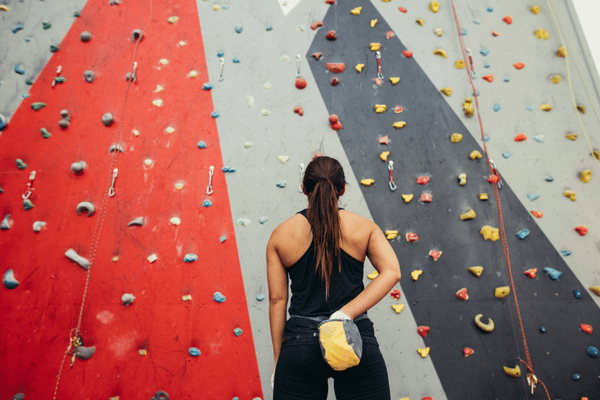
Fear of heights affects millions of people worldwide. Known as acrophobia, this common fear falls under phobias and impacts roughly 5-6% of the population. Up to one-third of people feel some discomfort or even vertigo when exposed to heights.
Acrophobia goes beyond normal caution around cliffs or tall buildings. It's an intense, irrational fear that can trigger panic and avoidance behaviors even in safe situations. The good news? This height phobia is very treatable with the right approach, just like many other phobias people experience.
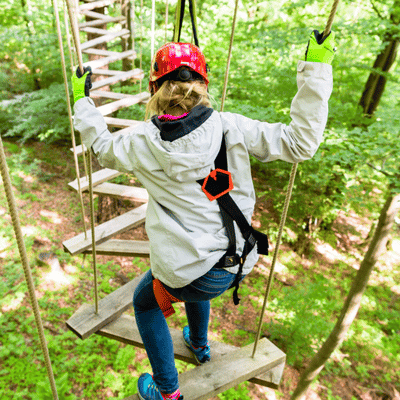
Acrophobia is an excessive fear of heights that falls under anxiety disorders. While feeling nervous on a high ledge is natural, acrophobia involves a much stronger fear response that disrupts daily life.
Common triggers include ladders, balconies, bridges, roofs, and looking out of skyscrapers windows. Someone with acrophobia might dread hotel rooms on upper floors or refuse to visit friends in high-rise apartments.
Standing on an observation platform, climbing up high, or riding in elevators could all cause intense anxiety. This leads to avoidance behaviors where people deliberately avoid height-related situations.
Such avoidance provides short-term relief but severely limits life activities. The Mayo Clinic notes that avoiding feared situations typically makes anxiety worse over time. This creates a vicious cycle where the fear grows stronger.
Humans seem hard-wired to be cautious of heights as an evolutionary survival instinct. Famous 1960 experiments showed even crawling infants refused to cross glass panels that looked like drop-offs.
This natural caution becomes exaggerated in acrophobia. The brain's normal fear-of-falling alarm gets stuck in overdrive. Research shows the mental image of falling often terrifies people more than the actual height itself.
This fear response can develop from past trauma like a bad fall. It can also be learned from watching parents react nervously to heights. Such experiences program the brain to treat heights as threats.
Risk factors include genetic predisposition to phobias, anxious temperaments, and sensitive balance systems. The vestibular system in your inner ear helps maintain balance. Problems here can make people feel unstable at heights.
When you're up high, your eyes see distant ground while usual visual cues disappear. This conflicts with your vestibular system and can trigger dizziness or vertigo. Your body tenses up to compensate for this sensory mismatch.
Research confirms that people with intense acrophobia show gait alterations when exposed to elevation. They walk slowly with shorter steps and keep both feet on the ground longer. These gait alterations are involuntary attempts to maintain safety.
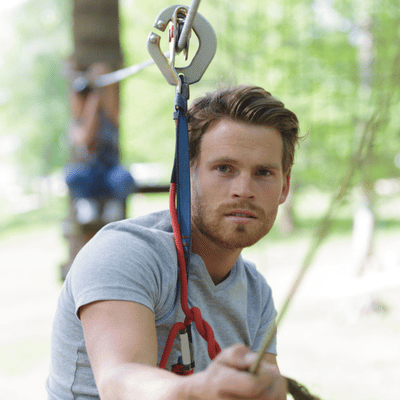
When someone with acrophobia encounters heights, their fight-or-flight response activates. Physical symptoms often include intense vertigo, nausea, trembling, and loss of balance sensations.
Many experience racing hearts, heart palpitations, sweating, and shortness of breath. Some report hyperventilation as adrenaline surges through their body. Feeling faint or weak in the knees when looking down is common.
Severe cases can trigger panic attacks with overwhelming terror, chest pain, and difficulty breathing. The urge to escape becomes overpowering.
Emotionally, people experience sheer panic and freeze up or cling to solid objects. They may not trust their sense of balance at all. Common reactions include dropping to hands and knees to feel more secure.
Catastrophic thoughts like "I'm going to fall" or "What if the railing breaks" fuel the anxiety further. This thinking pattern maintains the acrophobia cycle.
Behaviorally, avoidance behaviors become routine. People refuse rooftop restaurants, skip mountain trails with elevation, and avoid amusement park rides like roller coasters. Some won't take jobs in tall buildings or buy upper-level stadium seats.
This avoidance cycle shrinks opportunities over time. It can affect careers, social activities, and travel plans. Unfortunately, avoiding heights reinforces acrophobia instead of curing it.
Overcoming acrophobia takes time, but you can retrain your mind and body to respond calmly. Here are effective coping strategies:
Acknowledge Your Fear and Get Educated
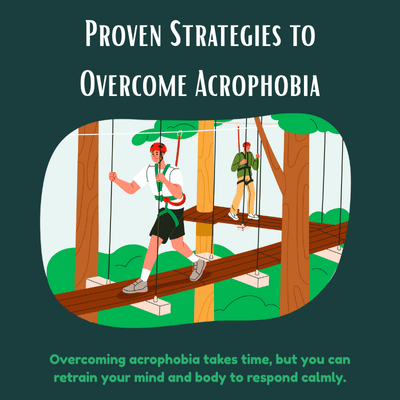
Start by understanding that acrophobia is a recognized condition among phobias. You're not alone, and you're not weak. Learn about the mechanisms behind your acrophobia. Understanding how your brain pairs heights with danger can empower you.
Remind yourself that your symptoms are false alarms. Your body reacts as if you're in grave danger when you're not. Accept that you have acrophobia but you're working to defeat it.
Practice Relaxation Techniques and Mindfulness
Since acrophobia triggers intense physical reactions, learn tools to calm your anxiety response. Deep breathing is simple and effective. When symptoms start, slow your breathing down.
Inhale through your nose for four counts, hold for two, then exhale through your mouth for six to eight counts. This prevents hyperventilation and steadies your heart rate.
Progressive muscle relaxation helps too. Tense and relax muscle groups from toes to head to relieve physical tension. Mindfulness meditation keeps you centered in the present moment.
Use Gradual Exposure Therapy
Exposure therapy is the gold standard treatment for acrophobia with very high success rates. Face your acrophobia in small, manageable steps until your brain relearns that heights are safe.
Start with less scary exposures like looking at photos of heights. Progress to standing on a step stool, then climbing a few ladders rungs with support. Eventually work up to visiting an observation platform or hiking trails with some elevation.
Stay in each situation long enough for initial panic to peak and subside. This teaches your body that anxiety waves pass without harm. Celebrate small wins and gradually push outside your comfort zone.
Consistency is key with exposure therapy. Regular exposure builds progress while long breaks can let acrophobia creep back.
Try Virtual Reality and Controlled Simulations
Virtual reality exposure therapy has emerged as an effective tool for acrophobia. VR headsets let you experience height scenarios in completely safe environments.
Studies show VR exposure can reduce acrophobia significantly. One trial found an average 68% reduction in fear scores among participants. Every person in the therapy group showed improvement.
Commercial VR apps for acrophobia are increasingly available. Mental health clinics often offer virtual reality exposure therapy sessions too.
Challenge Negative Thoughts
Acrophobia involves terrifying mental scenarios that fuel panic attacks. Cognitive behavioral therapy teaches you to challenge and reframe negative thoughts.
When facing heights, observe what you're thinking. Are you overestimating danger or underestimating your ability to cope? Talk back to fears with rational statements.
If you think "I'm going to fall," counter with "I'm on a solid platform with high railings. This structure prevents falling." Replace "I can't handle this" with "I might feel scared, but I know how to breathe and can handle a few minutes."
Memorize coping strategies to repeat at heights like "I am secure, this fear will pass" or "It's okay to feel afraid, but I'm in control."
Seek Support and Professional Help
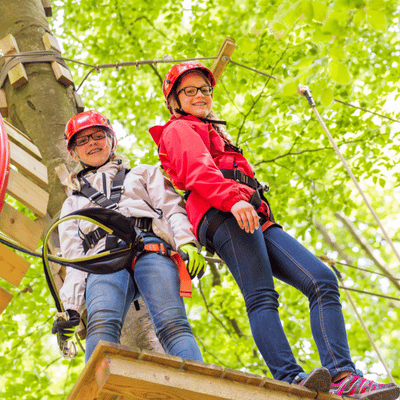
Don't tackle acrophobia alone. Ask trusted friends or family to accompany you on exposure outings. Having calm support makes a huge difference.
If acrophobia is very intense or longstanding, consider therapy with someone specializing in phobias. Professional treatment options include structured exposure exercises and deeper work on underlying thoughts.
Some cases benefit from short-term medication to ease symptoms before specific events. Sedatives or beta-blockers can temporarily suppress panic responses during desensitization therapy.
Acrophobia doesn't have to limit your world. Many people who initially feel terrified at heights go on to enjoy skyscrapers, bridges, and activities they never thought possible.
The rush of overcoming fear is incredibly empowering. Conquering acrophobia builds resilience that spills into other life areas, making everyday challenges more manageable.
Whether it's standing one foot closer to the edge than yesterday or reaching the top of an adventure tower, every victory matters. With consistent practice, what once caused symptoms can become fun.
Ready to start your journey? Book an adventure experience today. Face your acrophobia in a safe, supportive environment with professional guides and safety equipment. Your first step toward freedom from fear is just one click away.
